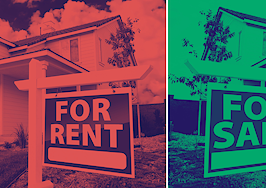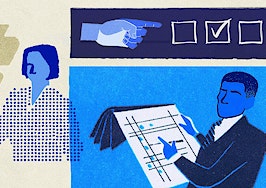In these times, double down — on your skills, on your knowledge, on you. Join us Aug. 8-10 at Inman Connect Las Vegas to lean into the shift and learn from the best. Get your ticket now for the best price.
If you earn $1 on a $10 investment, you earn a 10 percent return ($1 / $10). But what if you earn $1 on a $0 investment?
Any return on a $0 investment is an “infinite” return, since both $1 / $0 and $100 / $0 both equal infinity. You invested nothing yet you still earned money.
Unlike most other types of investments, it turns out that infinite returns are possible in real estate investing. It’s another reason I invest in real estate over bonds and other low-return investments.
What are infinite returns?
Real estate comes with a unique advantage over most other investments: You can borrow most of its value at a relatively low-interest rate.
That makes it possible to invest in a property, create equity through improvements and then refinance the property based on its new higher value. In refinancing, you can theoretically pull your original down payment and closing costs back out of the property.
You end up with $0 of your own money invested in the property, even as you continue earning cash flow and appreciation. Read: Infinite returns.
The mechanics of infinite returns work a little differently, depending on whether you invest actively or passively. But the principles behind both remain the same.
Rental properties and the BRRRR method
When I first started investing in real estate, I bought fixer-uppers. In some cases I did a full gut renovation, in others, I just made cosmetic improvements and boosted the curb appeal. I sold one or two for an influx of cash, but most I kept as rental properties and refinanced to pull back out my initial investment.
I could then recycle the same down payment over and over again. I continually added to my property portfolio with each property adding cash flow and appreciation — all with the same $50,000.
In real estate investing circles, we call this the BRRRR method: Buy, renovate, rent, refinance, repeat. It’s a fantastic investing strategy, in part because buying fixer-uppers helps you score great deals and then force equity through renovations.
And because you don’t need millions of dollars to build a large, recession-proof real estate portfolio.
Infinite returns on passive syndications
Don’t want to become a landlord?
I no longer invest actively in rental properties, because I spend most of the year overseas and I don’t want the headaches. Instead, I invest passively in real estate syndications.
These group investments let you buy fractional ownership in apartment complexes. In many cases, they follow a similar model as flipping houses or the BRRRR method, just on a larger scale. The sponsor finds a “value-add” property that needs updating and improvements, and after renovating it, they either sell it or refinance it.
If they refinance it, they return some or all of your initial capital back to you. But you keep your ownership share in the property, keep collecting cash flow, keep earning appreciation.
Syndication deals aren’t limited to apartment buildings either. You can invest in self-storage facilities, office buildings, mobile home parks, even farmland or mineral resources.
While real estate syndications typically require a $50,000-$100,000 minimum investment — similar to a down payment on a rental property — you can pool funds with other investors to invest with less. For example, our real estate investment club lets members invest in these deals with $5,000 instead of $50,000-$100,000.
Challenges with infinite returns
To begin with, infinite returns require you to buy a fixer-upper and renovate it at least if you plan to invest actively. And renovating properties takes a huge effort on your part, from pulling permits to hiring contractors to overseeing repairs and hassling with city inspectors.
That says nothing of the headaches of managing renters and property managers either.
If you invest passively through a real estate syndication, you don’t take on those headaches but you surrender control over the project. You don’t know exactly how much of your original investment you’ll return when it refinances either.
Labor aside, the greatest challenge with the BRRRR method is maintaining positive cash flow. If you borrow too much, it can leave you with no net cash flow or worse, negative cash flow.
The higher interest rates go, the greater the risk to your cash flow. And since you buy the fixer-upper months before you can refinance it, you don’t know how interest rates will change during that time. Add a cushion when calculating a deal’s cash flow, running the numbers with much higher interest rates than you actually expect.
Finally, bear in mind that you still need the initial capital to invest. Even if all goes according to plan, you still have to invest real money in the beginning before getting reimbursed through the refinance.
Are infinite returns possible in real life?
Yes, you can earn infinite returns in the real world — but it’s not common or easy.
Most active real estate investors I know who follow the BRRRR strategy end up leaving some cash tied up in the property. If they put down $50,000, they might pull $40,000 back out when they refinance, but that still leaves them with $10,000 of their own cash invested.
While that can give them high cash-on-cash returns on their remaining $10,000 of cash invested, they’re still earning a finite return.
The same happens with syndications. Most sponsors can’t pull 100 percent of the invested capital back out when they refinance, at least if they hope to keep earning positive cash flow. So they pull out 60-80 percent to return to investors and it remains a win. Investors can redeploy that capital in new investments, even as they keep earning cash flow from the original deal.
Still, infinite returns do happen. You may not be able to pull every penny back out of a property when you refinance, but by pursuing this strategy, you can sometimes achieve the incredible feat of earning something on nothing.
G. Brian Davis is a real estate geek and co-founder of SparkRental.
Get Inman’s Property Portfolio Newsletter delivered right to your inbox. A weekly roundup of news that real estate investors need to stay on top, delivered every Tuesday. Click here to subscribe.













